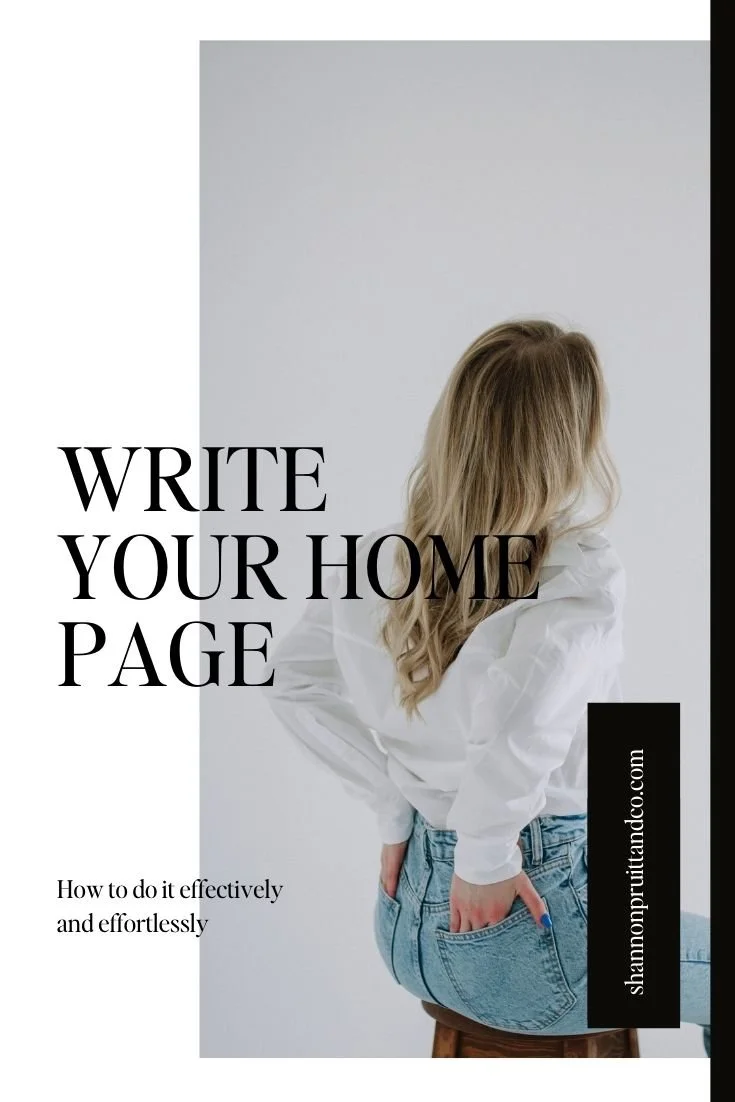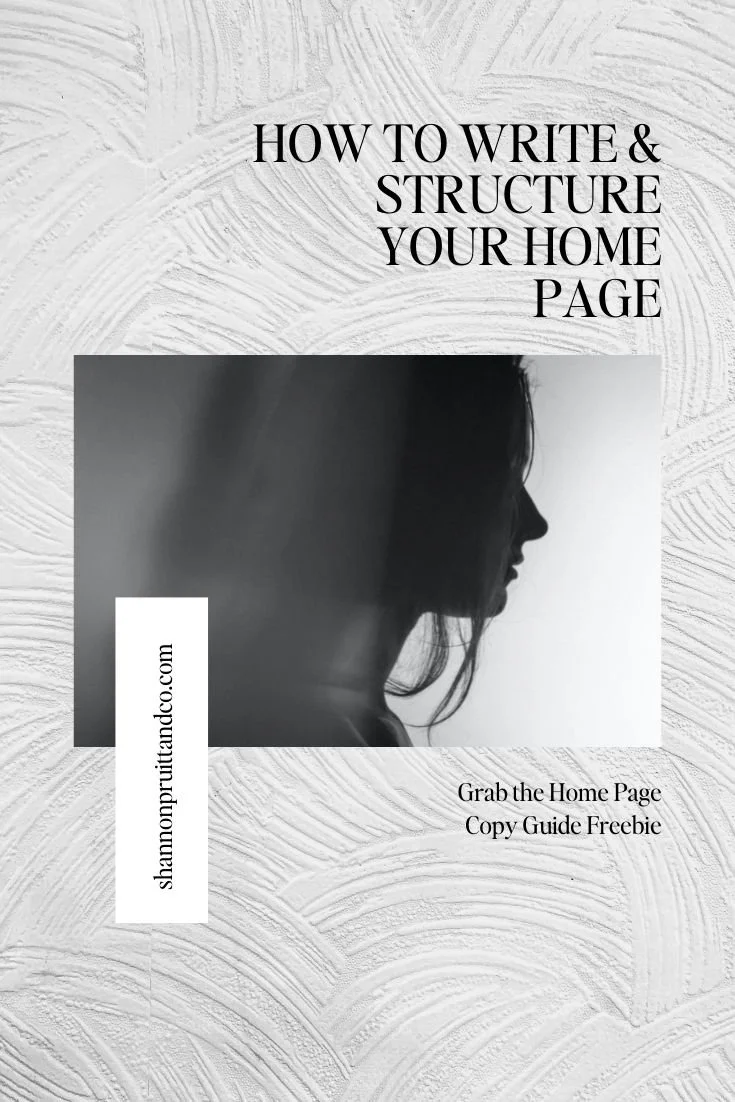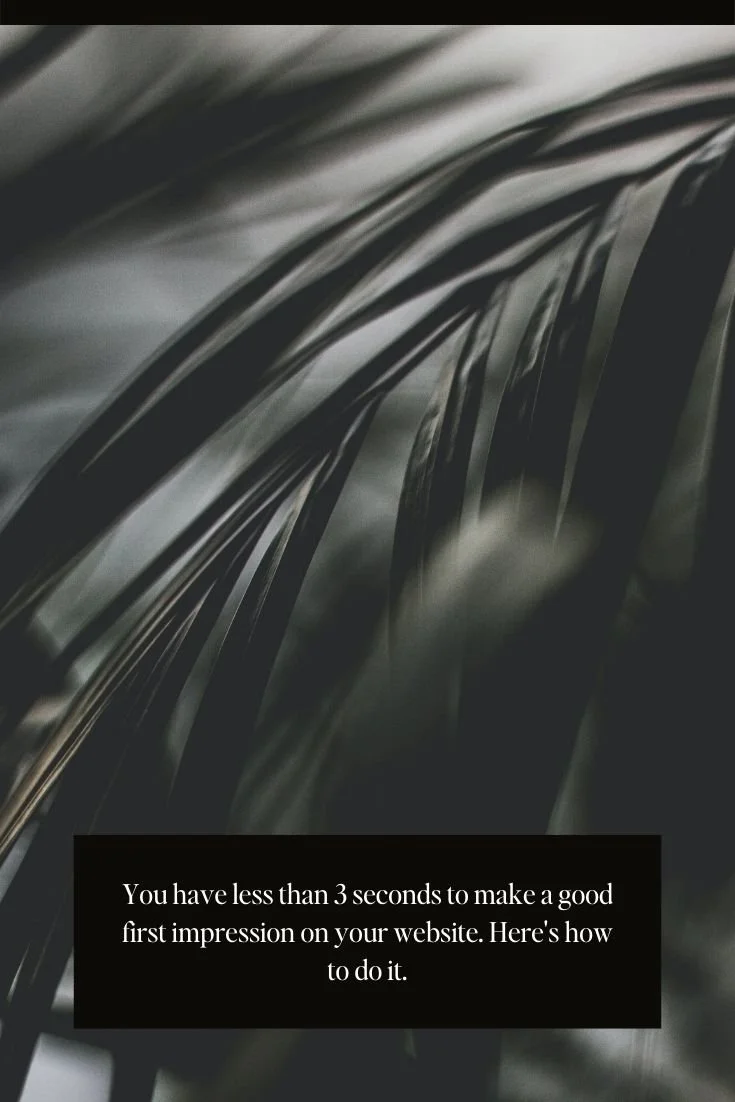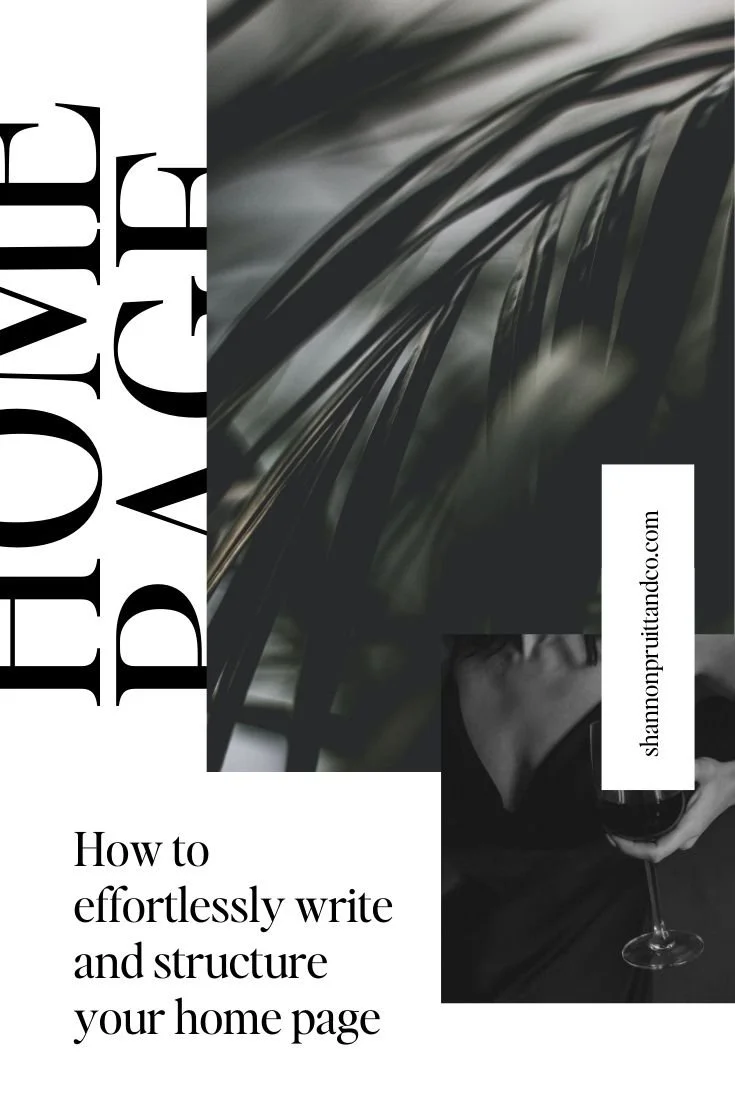Revealed: How to Effortlessly Write and Structure Your Home Page on Your Website
Writing and structuring the home page of your website can cause a lot of frustration and bring you to tears if you don’t know what to do. It’s an important page of your website. I mean, it’s what gives your website visitors a first impression of you.
And we all know how powerful first impressions are.
I mean, I’m thinking back to several Tinder dates and cringing. 😣
Home Pages are kind of like that first date anyway. You show up, waiting on your date (aka, your website visitor), hoping that you look good, sound good, and that they realize you’re the one. You want them to walk into the room (or land on your site), and think, “OOOooo-weee. YES. This is who I’ve been looking for!”
So since your home page is your website visitor’s first impression of you, you need to nail the copy and structure.
But what if you’ve tried, and you’ve hit writer’s block? Or maybe you’ve just stared at the computer screen without a clue as to where to start? Or perhaps you’ve gone down the rabbit hole looking at other home pages and got so overwhelmed that you pushed your own to the back burner?
It’s common to feel this way. You’re not alone.
Writing a home page is HARD. You don’t want to overwhelm your visitor with so much information they “X” out. But you want to give juuuuust enough info so that their curiosity is piqued enough that they keep going through your site. Or—best case scenario—your home page is written SO PERFECTLY that they immediately reach out to hire you or immediately purchase from you.
WINNING.
Today I’m going to walk you through how to structure and write compelling copy that converts your visitor into contacting you and purchasing from you.
Overview of Your Home Page
So someone has landed on your doorstep, the home page of your website. You want to invite them in, but in order to do that, you need to make them feel comfortable. You need to entice them and give them enough intrigue to make them want to step over the threshold.
And you have less than 3 seconds to do it.
That’s a tall order. Let’s see if I can help.
The goal of your home page is three-fold:
Create trust.
Build authority.
Point to next steps.
You're going to do this through 5 ways:
Show who you are. Show your visitor that you are who they're looking for.
Show why you’re worth hiring or buying from. Show how you’re an expert and have legitimacy.
Show who you work with. First time home buyers? Engaged couples? Stay at home moms? Working moms? Entrepreneurs? Be specific. Look at your ideal client info.
Show the main benefit of working with you. Show your visitor what he or she gets when they hire you or purchase from you.
Show your visitor how to get started and what to do next. This can be a process of sorts, or a very simple CTA.
One of the first things you need to do is figure out your Customer Journey. There needs to be a clear next step and a clear next step after that, and so on. It’s your job to make the purchasing or hiring process simple. Map out where you want your visitors to go next. How do you want them to journey through your website?
For most service providers, I suggest pointing your visitor to your Services page after your home page.
For most product brands, I suggest pointing your visitor to your online Shop.
For other brands, it depends on your goals and offerings.
The Anatomy & Structure of Your Home Page
Let’s break down the structure of your home page and look at some killer examples. And it’s important to note that this structure can be adjusted for any brand.
Section 1: the Headline
Purpose of your headline: Grab your visitor’s attention. Portray your unique value proposition (or secret sauce). Tell your visitor what your website is all about. Let your visitor know they’re in the right place.
How:
Main Headline + Subheadline + Call-to-Action (CTA)
You need to grab your visitor’s attention, connect with them, and reflect your positioning. You can do this by sharing a benefit, agitating a pain point, reflecting an emotion, mentioning a desired result, or sharing a thought-provoking fact. You are also communicating your unique value proposition. And either your main headline or your subheadline should have the keywords someone is searching for to find you (*see Notes below, though). Lastly, your CTA needs to be clever and point your visitor to the very next step in their customer journey.
You can format this several different ways: Eyebrow Text (the little text that sits above the main headline), Main Headline, Subheadline, CTA is a great option! You’ll see this below in some of the examples.
Notes:
Your H1 on your home page should have your main keyword. This is the main keyword people use to find you on Google. So whether that’s your Main Headline or Subheadline, one of them needs to be formatted as an H1 and needs to have your SEO keyword. This looks different from one web design platform to another one.
All of this is happening above the fold. That means that before someone scrolls down your home page, she’s going to see your Main Headline, Subheadline, and CTA.
Examples:
Jenna Kutcher’s got a GREAT website. It’s beautifully designed and has personality-driven copy.
I’m a personal fan of Little Z’s and am impressed with the copy on their home page, as well. You’ll notice that they implemented eyebrow text instead of a subheadline—totally ok!
I stumbled on Noteworthy on Instagram, and their home page is a great example of well-written copy. They actually used two CTAs above the fold, which I typically don’t recommend, but it works for this product-based brand.
Who doesn’t love Jeni’s ice cream? You’ll see they implemented eyebrow text, too.
Section 2: optional Social Proof and Authority
NOTE: The rest of your home page happens below the fold, meaning that your visitor will view the rest of your home page once they start scrolling.
Purpose: Show you have legitimacy and are an expert at what you do or what you offer.
How:
Add logos of clients you’ve worked with
Add logos of publications or other media you’ve been featured in
Add logos of brands who sponsor or endorse you
Notes: Again, this section is optional. You don’t have to have it, but if you’ve worked with some well-known brands, it’s definitely something to consider.
Examples:
Katrina Scott showcases her feature with Sports Illustrated (as she should!)
And Jenna Kutcher shows off her media features by displaying color-cohesive logos.
Section 3: optional Mini About
Purpose: Briefly introduce who you, connect with your visitor, and build more credibility
How:
This is brief. All you need is a quality photo of yourself and some text.
Be conversational, like you’re talking to a friend. This is going to show your personality.
Don’t toss all your superlatives and awards here. Consider including one (maybe 2) authority builder strengths here (number of clients you’ve worked with, years of experience, etc.)
Quickly mention how you’re going to help them with their main problem and give them their desired result
Be sure to give a CTA to your About Page where they can learn more about you.
Notes:
If you’re a personal brand or if you’re the face of your brand, I always recommend introducing yourself somewhere on your home page.
Keep it short and sweet.
Examples:
Since Jenna Kutcher is the face of her brand, it makes sense that she added a mini about section to her home page. It, of course, is well-written, packed with personality, and doesn’t sound salesy. (The image of her appears blurry, but in reality it’s not—it’s a cute gif/video that I took a screenshot of so I could annotate it).
Section 4: Brief Explanation
Purpose: Show your visitor you understand what they're going through. Show them you get it. (<<<Notice—again—I'm not saying to tell them. You need to show them. Show, don't tell.) Agitate their problem juuuust a tiny bit so they realize how much they need or want a solution.
How:
Tell a quick story, or
Give a quick lesson, or
Spout off some quick facts.
Examples:
Jeni’s gently shows they know what you’re looking for and throws in their unique value proposition. The problem Jeni’s solves = boring ice cream flavors. How they solve it = giving you unforgettable, crave-worthy ice cream flavors. How you benefit = ice cream so good that it’s going to bring you and your loved ones together. Boom. Literally one line of copy that packs a punch.
Even if you go beyond line of copy, it’s ok. Little Z’s shows they understand what you’re going through and what you’re looking for. They’re also saying it completely in line with their brand voice (gentle, empathetic, friendly, approachable), so it works. The problem they solve = helping you how teach your baby how to sleep. The result you’re looking for = a sleeping baby. How you’ll benefit (other than a sleeping baby) = confidence and peace of mind in knowing you have a support system and know what to do when your baby goes through developmental changes that impact sleep.
Section 5: Unique Value Proposition
Purpose: To show your visitor why they should hire you. Why are you different?
How:
Now that their problem and struggle is sitting at the top of their mind and they realize they need help, go deeper on why they should hire you or purchase from you.
Review what you briefly mentioned in your Section 1 headline.
Notes: This can be combined with your quick explanation above. You don’t have to have these in two separate sections or canvases of your website.
Examples:
Jeni’s expands on their unique value proposition here by breaking it down and briefly expanding it into 3 very simple distinctions.
Noteworthy shows off their unique value proposition the same way Jeni’s did: by breaking it down into 3 areas that makes then stand out from other fragrance brands.
Section 6: Intro to Your Primary Offerings and Main Benefit
Purpose: Give a quick overview of how you can help your visitor
How:
And now that they know why they should hire you over someone else, showcase a brief overview of the main benefit of working with you or purchasing from you.
Then briefly share your top 3-4 services, products, or offerings.
Examples:
Jenna Kutcher highlights her primary offerings on her home page of her website:
Little Z’s showcases their two primary offerings: Sleep E-Coaching and Sleep Society. They then briefly break down the benefits and features of each program so you can compare.
Section 7: Social Proof
Purpose: Provide credibility. This is a psychological tactic that works. By showing your visitor that others trust you, rave about you, and experience a solid return on their investment, you're going to show them how credible you are.
How:
You can do this by putting up your best testimonials, or social media comments, or even DMs.
Other ideas to show social proof is to brag about the number of people you've served or how many products you've sold.
Even showing an overview of the results someone can expect is a great way to show social proof.
Example:
Jeni’s showcases social proof through reviews from well-known brands. This is a double-win: social proof through reviews + building authority through brand association.
Noteworthy displays reviews and testimonials from their customers.
Like Noteworthy, Little Z’s also displays reviews and testimonials from their customers.
Section 8: Next Steps
Purpose: Give your visitors the first step. How do they get started? What should they do next?
How:
This depends entirely on your customer journey and where you want your visitor to specifically go next.
Examples: Services Page, Click Here to Get Started, Next Steps, Contact
Examples:
Noteworthy breaks down how to get started and how the fragrance personalization process works in 3 easy steps.
Jeni’s displays a quick overview of their ice cream shipping process.
Section 9: kinda-optional Lead Generation / Opt-in Opportunity
I say “kinda-optional” because I realize you may not have an incentive for your visitor to opt-in yet. BUT, if you want to collect email addresses (which, you should), you need to give your visitors a chance to actually opt-in to receiving your emails. And the best way to do this is to provide something of value. Not sure how to build your email list with a Lead Magnet? Read my top tips here.
Purpose: For those visitors who aren't ready to get started working with you or purchasing from you, see if you can convince them to opt-in to whatever content upgrade, freebie, or lead magnet you have.
Example:
Katrina Scott asks you to sign up for her newsletter but gives you a benefit/lead magnet/freebie in exchange for your email address.
Jenna Kutcher had a few freebies on her home page, but I can’t find my screenshot…and honestly? I’m tired at this point #workingmomma. But go check out her home page to see how she offers up lead magnets.
Section 10: Recent Blog Posts/Content Highlights
Purpose: Build more credibility, and have your visitor stick around your website as long as possible
How:
This is where you're going to showcase your featured, most popular, or recent blog posts, YouTube videos, social media posts, etc.
You want to give more to the visitors who want MORE.
Plus, keeping your visitors on your website helps boost your website's credibility and SEO.
Example:
Jenna Kutcher shows off her top blog posts and even intros this section by telling visitors what they’re going to gain by reading through the blog.
Section 11: Final, Hail Mary, CTA
Purpose: Point your visitor to the next step in their journey. What action do you want them to take? Generally this is the same action that you give them in Part 1.
How:
Your visitors have reached the bottom of your website. Tell them where to go next.
Be very specific. If you're a Service Provider, send them to your Services page. If you're an eCommerce Store, send them to your Shop.
Example:
Noteworthy gives one last CTA at the bottom of their home page for anyone who scrolled all the way to the bottom.
There’s how to write and structure a solid home page so you make an attention-grabbing first impression with your website visitor. And—hopefully—convert them to a paying customer.
































